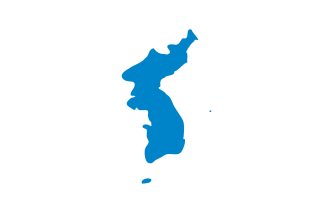
Korea is a peninsular region in East Asia. Since 1945, it has been divided at or near the 38th parallel, now known as the Korean Demilitarized Zone. In 1948, two states declared independence, both claiming sovereignty over all of Korea: South Korea comprising its southern half and North Korea comprising its northern half. The region consists of the Korean Peninsula, Jeju Island, and a number of minor islands near the peninsula. The peninsula is bordered by China (Manchuria) to the north and Russia to the northeast, across the Amnok and Duman rivers. It is separated from Japan to the southeast by the Korea Strait.
Lists of battles contain links to sets of articles on battles. They may be organized alphabetically, by era, by conflict, by participants or location, or by death toll. See Category:Battles for a complete list of articles on battles.

This is a timeline of Afghan history, comprising important legal and territorial changes and political events in Afghanistan and its predecessor states. To read about the background to these events, see History of Afghanistan. See also the list of heads of state of Afghanistan and the list of years in Afghanistan.

The national flag of the Republic of Korea, also known as the Taegeukgi, has three parts: a white rectangular background, a red and blue Taegeuk in its center, accompanied by four black trigrams, one in each corner. Flags similar to the current Taegeukgi were used as the national flag of Korea by the Joseon dynasty, the Korean Empire, as well as the Korean government-in-exile during Japanese rule. South Korea adopted the Taegeukgi as its national flag when it gained independence from Japan on 15 August 1945.

The division of Korea began with the 15 August 1945 official announcement of the surrender of Japan, thus ending the Pacific Theater of World War II. During the war, the Allied leaders had already been considering the question of Korea's future following Japan's eventual surrender in the war. The leaders reached an understanding that Korea would be liberated from Japan but would be placed under an international trusteeship until the Koreans would be deemed ready for self-rule. In the last days of the war, the United States proposed dividing the Korean peninsula into two occupation zones with the 38th parallel as the dividing line. The Soviets accepted their proposal and agreed to divide Korea.

The governor-general of Taiwan was the head of the Government-General of Taiwan in the Japanese era when they were part of the Empire of Japan, from 1895 to 1945.

2009: Lost Memories is a 2002 South Korean science fiction action film directed by Lee Si-myung, adapted from the 1987 novel Looking for an Epitaph by Bok Geo-il. The film takes place in an alternate 2009, where the Korean Peninsula is still part of Imperial Japan due to a time-travel incident in 1909. It was distributed by CJ Entertainment and was released on February 1, 2002.
World War II officially ended in Asia on September 2, 1945, with the surrender of Japan on the USS Missouri. Before that, the United States dropped two atomic bombs on Japan, and the Soviet Union declared war on Japan, causing Emperor Hirohito to announce the acceptance of the Potsdam Declaration on August 15, 1945, which would eventually lead to the surrender ceremony on September 2.
Nate (Korean: 네이트) is a South Korean web portal, developed by SK Communications. In 2003, Nate acquired social media site Cyworld and in 2004, it achieved first place in local page views with a total of 3.8 million, surpassing rival Daum for the first time. But its popularity have continuously decreased since early 2010s and as of 2020, its market share in South Korea is around 2%.
The following lists events that happened during 1945 in New Zealand.

This is a timeline of Korean history.
This is a timeline of Japanese history, comprising important legal, territorial and cultural changes and political events in Japan and its predecessor states. To read about the background to these events, see History of Japan.
The decolonisation of Asia was the gradual growth of independence movements in Asia, leading ultimately to the retreat of foreign powers and the creation of several nation-states in the region.
The following are timelines of modern history, from the end of the Middle Ages, c. 1400 – c. 1500, to the present.
This page is based on this
Wikipedia article Text is available under the
CC BY-SA 4.0 license; additional terms may apply.
Images, videos and audio are available under their respective licenses.






